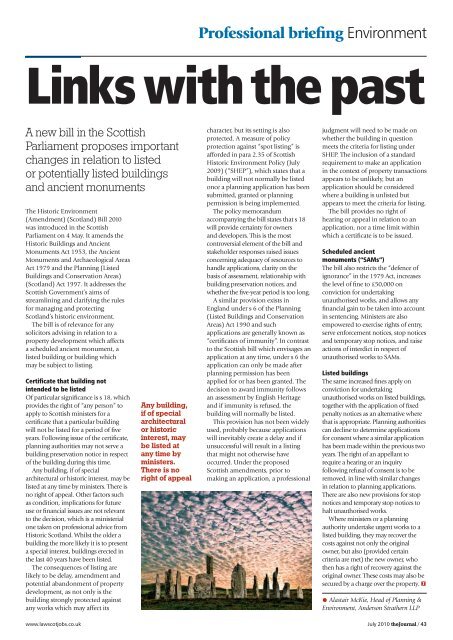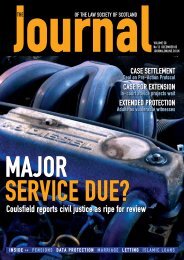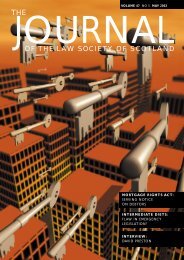Professional briefing - The Journal Online
Professional briefing - The Journal Online
Professional briefing - The Journal Online
Create successful ePaper yourself
Turn your PDF publications into a flip-book with our unique Google optimized e-Paper software.
<strong>Professional</strong> <strong>briefing</strong> Environment<br />
Links with the past<br />
A new bill in the Scottish<br />
Parliament proposes important<br />
changes in relation to listed<br />
or potentially listed buildings<br />
and ancient monuments<br />
<strong>The</strong> Historic Environment<br />
(Amendment) (Scotland) Bill 2010<br />
was introduced in the Scottish<br />
Parliament on 4 May. It amends the<br />
Historic Buildings and Ancient<br />
Monuments Act 1953, the Ancient<br />
Monuments and Archaeological Areas<br />
Act 1979 and the Planning (Listed<br />
Buildings and Conservation Areas)<br />
(Scotland) Act 1997. It addresses the<br />
Scottish Government’s aims of<br />
streamlining and clarifying the rules<br />
for managing and protecting<br />
Scotland’s historic environment.<br />
<strong>The</strong> bill is of relevance for any<br />
solicitors advising in relation to a<br />
property development which affects<br />
a scheduled ancient monument, a<br />
listed building or building which<br />
may be subject to listing.<br />
Certificate that building not<br />
intended to be listed<br />
Of particular significance is s 18, which<br />
provides the right of “any person” to<br />
apply to Scottish ministers for a<br />
certificate that a particular building<br />
will not be listed for a period of five<br />
years. Following issue of the certificate,<br />
planning authorities may not serve a<br />
building preservation notice in respect<br />
of the building during this time.<br />
Any building, if of special<br />
architectural or historic interest, may be<br />
listed at any time by ministers. <strong>The</strong>re is<br />
no right of appeal. Other factors such<br />
as condition, implications for future<br />
use or financial issues are not relevant<br />
to the decision, which is a ministerial<br />
one taken on professional advice from<br />
Historic Scotland. Whilst the older a<br />
building the more likely it is to present<br />
a special interest, buildings erected in<br />
the last 40 years have been listed.<br />
<strong>The</strong> consequences of listing are<br />
likely to be delay, amendment and<br />
potential abandonment of property<br />
development, as not only is the<br />
building strongly protected against<br />
any works which may affect its<br />
www.lawscotjobs.co.uk<br />
Any building,<br />
if of special<br />
architectural<br />
or historic<br />
interest, may<br />
be listed at<br />
any time by<br />
ministers.<br />
<strong>The</strong>re is no<br />
right of appeal<br />
character, but its setting is also<br />
protected. A measure of policy<br />
protection against “spot listing” is<br />
afforded in para 2.35 of Scottish<br />
Historic Environment Policy (July<br />
2009) (“SHEP”), which states that a<br />
building will not normally be listed<br />
once a planning application has been<br />
submitted, granted or planning<br />
permission is being implemented.<br />
<strong>The</strong> policy memorandum<br />
accompanying the bill states that s 18<br />
will provide certainty for owners<br />
and developers. This is the most<br />
controversial element of the bill and<br />
stakeholder responses raised issues<br />
concerning adequacy of resources to<br />
handle applications, clarity on the<br />
basis of assessment, relationship with<br />
building preservation notices, and<br />
whether the five-year period is too long.<br />
A similar provision exists in<br />
England under s 6 of the Planning<br />
(Listed Buildings and Conservation<br />
Areas) Act 1990 and such<br />
applications are generally known as<br />
“certificates of immunity”. In contrast<br />
to the Scottish bill which envisages an<br />
application at any time, under s 6 the<br />
application can only be made after<br />
planning permission has been<br />
applied for or has been granted. <strong>The</strong><br />
decision to award immunity follows<br />
an assessment by English Heritage<br />
and if immunity is refused, the<br />
building will normally be listed.<br />
This provision has not been widely<br />
used, probably because applications<br />
will inevitably create a delay and if<br />
unsuccessful will result in a listing<br />
that might not otherwise have<br />
occurred. Under the proposed<br />
Scottish amendments, prior to<br />
making an application, a professional<br />
judgment will need to be made on<br />
whether the building in question<br />
meets the criteria for listing under<br />
SHEP. <strong>The</strong> inclusion of a standard<br />
requirement to make an application<br />
in the context of property transactions<br />
appears to be unlikely, but an<br />
application should be considered<br />
where a building is unlisted but<br />
appears to meet the criteria for listing.<br />
<strong>The</strong> bill provides no right of<br />
hearing or appeal in relation to an<br />
application, nor a time limit within<br />
which a certificate is to be issued.<br />
Scheduled ancient<br />
monuments (“SAMs”)<br />
<strong>The</strong> bill also restricts the “defence of<br />
ignorance” in the 1979 Act, increases<br />
the level of fine to £50,000 on<br />
conviction for undertaking<br />
unauthorised works, and allows any<br />
financial gain to be taken into account<br />
in sentencing. Ministers are also<br />
empowered to exercise rights of entry,<br />
serve enforcement notices, stop notices<br />
and temporary stop notices, and raise<br />
actions of interdict in respect of<br />
unauthorised works to SAMs.<br />
Listed buildings<br />
<strong>The</strong> same increased fines apply on<br />
conviction for undertaking<br />
unauthorised works on listed buildings,<br />
together with the application of fixed<br />
penalty notices as an alternative where<br />
that is appropriate. Planning authorities<br />
can decline to determine applications<br />
for consent where a similar application<br />
has been made within the previous two<br />
years. <strong>The</strong> right of an appellant to<br />
require a hearing or an inquiry<br />
following refusal of consent is to be<br />
removed, in line with similar changes<br />
in relation to planning applications.<br />
<strong>The</strong>re are also new provisions for stop<br />
notices and temporary stop notices to<br />
halt unauthorised works.<br />
Where ministers or a planning<br />
authority undertake urgent works to a<br />
listed building, they may recover the<br />
costs against not only the original<br />
owner, but also (provided certain<br />
criteria are met) the new owner, who<br />
then has a right of recovery against the<br />
original owner. <strong>The</strong>se costs may also be<br />
secured by a charge over the property.<br />
Alastair McKie, Head of Planning &<br />
Environment, Anderson Strathern LLP<br />
July 2010 the<strong>Journal</strong> / 43










